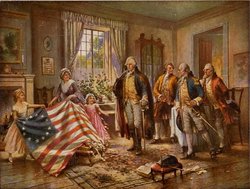| HOME ||
CHARACTER EDUCATION ACROSS THE CURRICULUM |
||
|
[CLICK for
.jpg PAGE 1] AMERICAN FREEDOMS COMPACT PROGRAM Student's Name________________________________ School________________________ Grade _Fifth CHARACTER ATTRIBUTE: HELPFUL, KIND and FRIENDLY Democratic Principle No. 7: Each individual has a responsibility to the group as well as to the total society. Students' Concept of the Principle: We believe that among our responsibilities are those of being helpful, kind and friendly to others both in word and in deed.
MY FREEDOMS COMPACT GOALS: I will...
1. Take suggestions from my parents and family members for improving
my behavior without getting angry or sulking. MY FREEDOMS COMPACT ACCOMPLISHMENTS:
1. This is a hard goal to completely accomplish but I'm improving,
according to my mother.
(Helpful, Kind and Friendly) An act of kind, helpful friendliness brought about the writing of our national anthem, The Star Spangled Banner. The United States was at war with Great Britain in the War of 1812. the Revolutionary War had previously been won but the British continued to harass the Colonists by land and by sea. During the day of September 13, 1814, the British took a number of prisoners in Baltimore whom they suspected of being spies. One of these was Dr. William Beans, an aged medical doctor who was a refugee from England and whom the British regarded as a spy. One of Dr. Bean's acquaintances was a young lawyer by the name of Francis Scott Key, a kind, friendly man who knew that Dr. Beans was not a spy and who was willing to risk his life to have the doctor released and returned home. By this time the doctor was aboard a British war ship anchored in the waters of the Chesapeake Bay. Mr. Key managed to get to the British navel officers and convinced them that Dr. Beans was not a spy and should be released. It was then late in the evening and the British allowed the doctor and Mr. Beans to remain on a Flagship until morning before returning to Baltimore. All night shells from British ships on the near shore bombarded America's Fort McHenry on the bay. Neither Dr. Beans nor Mr. Key slept very well that night. In the early morning hours Dr. Beans looked through a porthole in the ship to see if the American flag was still flying over Fort McHenry. The British had hurried him out of his office so rapidly the day before that he left his glasses on his desk. Not being able to see very well and so anxious to know whether Fort McHenry was still in our American possession, he got Mr. Key to stand on a chair to peer out and see if the flag was still there. "Is it there, it it still there?" queried the doctor. "Yes it is!" replied Mr. Key who then sat down and wrote the words of the "Star Spangled Banner" on an envelope he took from his pocket. Soon he put the words to the tune of an old British folk song by an English song writer, John Stafford Smith. The song soon became popular. On March 3, 1931, it officially became our national anthem in a bill signed by President Herbert Hoover. Without Francis Scott Key's helpful, kind and friendly act with Dr. Beans, Americans would never have had the "Star Spangled Banner" as our national anthem.
|
